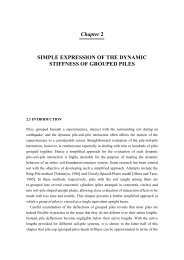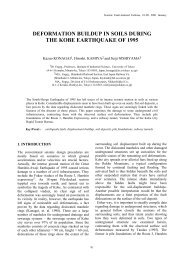Damage of Bridges Resulting from Surface Rupture of Faults in the ...
Damage of Bridges Resulting from Surface Rupture of Faults in the ...
Damage of Bridges Resulting from Surface Rupture of Faults in the ...
Create successful ePaper yourself
Turn your PDF publications into a flip-book with our unique Google optimized e-Paper software.
Photo 9 Bolu Viaduct<br />
Photo 10 Girder Offset <strong>from</strong> <strong>the</strong> Pier<br />
Photo 11 Shear Failure <strong>of</strong> Deck result<strong>in</strong>g <strong>from</strong><br />
<strong>the</strong> Offset <strong>of</strong> Girder <strong>from</strong> <strong>the</strong> Pier<br />
Photo 12 <strong>Damage</strong>d Energy Dissipat<strong>in</strong>g Unit and<br />
Viscous Damper Stopper<br />
Photo 13 Energy Dissipat<strong>in</strong>g Elements that suffered<br />
<strong>Damage</strong> result<strong>in</strong>g <strong>from</strong> Excessive Movement<br />
<strong>of</strong> <strong>the</strong> Deck<br />
seismically active and a fault <strong>of</strong>fset was<br />
anticipated 3) . The Viaduct was designed assum<strong>in</strong>g<br />
<strong>the</strong> maximum ground acceleration <strong>of</strong> 0.4g <strong>in</strong><br />
accordance with <strong>the</strong> 1983 AASHTO<br />
Specifications 8) with some modifications. Ma<strong>in</strong><br />
difference <strong>from</strong> <strong>the</strong> AASHTO Guide Specifications<br />
was <strong>the</strong> response modification factor R; Although<br />
AASHTO specified a value <strong>of</strong> R=3 for s<strong>in</strong>gle<br />
columns, R=1 was used <strong>in</strong> design <strong>of</strong> Bolu Viaduct<br />
to ensure elastic response <strong>in</strong> <strong>the</strong> piers 3) .<br />
(3) <strong>Damage</strong> <strong>of</strong> Bolu Viaduct<br />
In 1999, <strong>the</strong> Bolu Viaduct experienced <strong>the</strong><br />
Kocaeli Earthquake as well as <strong>the</strong> Duzce<br />
Earthquake. Although <strong>the</strong> epicenter <strong>of</strong> <strong>the</strong> Kocaeli<br />
Earthquake was about 100km away <strong>from</strong> <strong>the</strong> Bolu<br />
Photo 14 Cable Restra<strong>in</strong>ers<br />
Viaduct, it was not far <strong>from</strong> <strong>the</strong> east end <strong>of</strong> <strong>the</strong> fault<br />
rupture. The energy dissipat<strong>in</strong>g unit had elastic<br />
displacements <strong>in</strong> <strong>the</strong> order <strong>of</strong> 44-80mm 3) .<br />
The epicenter <strong>of</strong> Duzce Earthquake was about<br />
6km south <strong>of</strong> Duzce, and <strong>the</strong> Bolu Viaduct was<br />
close to Duzce. The fault crossed <strong>the</strong> Bolu Viaduct<br />
at Pier 45 and Pier 47 at an angle <strong>of</strong> approximately<br />
20-30 degrees with <strong>the</strong> bridge axis. The right lateral<br />
<strong>of</strong>fset was approximately 2-2.5m 3) .<br />
Most decks moved <strong>in</strong> longitud<strong>in</strong>al and transversal<br />
directions. At several piers, <strong>the</strong> girders <strong>of</strong>fset <strong>from</strong><br />
<strong>the</strong> pedestal, and were hung only by <strong>the</strong> concrete<br />
decks as shown <strong>in</strong> Photo 10. Consequently, <strong>the</strong><br />
concrete deck suffered extensive shear failure as<br />
shown <strong>in</strong> Photo 11. Some decks were about to fall<br />
down. Based on <strong>the</strong> site <strong>in</strong>spection, it seemed that<br />
179






